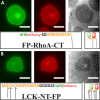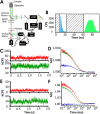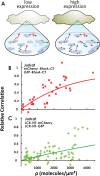Monitoring lipid anchor organization in cell membranes by PIE-FCCS
- PMID: 22631607
- PMCID: PMC3626236
- DOI: 10.1021/ja300374c
Monitoring lipid anchor organization in cell membranes by PIE-FCCS
Abstract
This study examines the dynamic co-localization of lipid-anchored fluorescent proteins in living cells using pulsed-interleaved excitation fluorescence cross-correlation spectroscopy (PIE-FCCS) and fluorescence lifetime analysis. Specifically, we look at the pairwise co-localization of anchors from lymphocyte cell kinase (LCK: myristoyl, palmitoyl, palmitoyl), RhoA (geranylgeranyl), and K-Ras (farnesyl) proteins in different cell types. In Jurkat cells, a density-dependent increase in cross-correlation among RhoA anchors is observed, while LCK anchors exhibit a more moderate increase and broader distribution. No correlation was detected among K-Ras anchors or between any of the different anchor types studied. Fluorescence lifetime data reveal no significant Förster resonance energy transfer in any of the data. In COS 7 cells, minimal correlation was detected among LCK or RhoA anchors. Taken together, these observations suggest that some lipid anchors take part in anchor-specific co-clustering with other existing clusters of native proteins and lipids in the membrane. Importantly, these observations do not support a simple interpretation of lipid anchor-mediated organization driven by partitioning based on binary lipid phase separation.
Figures






Similar articles
-
Detection of rhodopsin dimerization in situ by PIE-FCCS, a time-resolved fluorescence spectroscopy.Methods Mol Biol. 2015;1271:205-19. doi: 10.1007/978-1-4939-2330-4_14. Methods Mol Biol. 2015. PMID: 25697526
-
The oxygen-substituted palmitic acid analogue, 13-oxypalmitic acid, inhibits Lck localization to lipid rafts and T cell signaling.Biochim Biophys Acta. 2002 Apr 3;1589(2):140-50. doi: 10.1016/s0167-4889(02)00165-9. Biochim Biophys Acta. 2002. PMID: 12007789
-
Single-molecule diffusion reveals similar mobility for the Lck, H-ras, and K-ras membrane anchors.Biophys J. 2006 Aug 1;91(3):1090-7. doi: 10.1529/biophysj.105.079053. Biophys J. 2006. PMID: 16920696 Free PMC article.
-
Resolving Membrane Protein-Protein Interactions in Live Cells with Pulsed Interleaved Excitation Fluorescence Cross-Correlation Spectroscopy.Acc Chem Res. 2020 Apr 21;53(4):792-799. doi: 10.1021/acs.accounts.9b00625. Epub 2020 Mar 31. Acc Chem Res. 2020. PMID: 32227891 Review.
-
GPI-anchored protein organization and dynamics at the cell surface.J Lipid Res. 2016 Feb;57(2):159-75. doi: 10.1194/jlr.R062885. Epub 2015 Sep 22. J Lipid Res. 2016. PMID: 26394904 Free PMC article. Review.
Cited by
-
Current Methods for Detecting Cell Membrane Transient Interactions.Front Chem. 2020 Dec 7;8:603259. doi: 10.3389/fchem.2020.603259. eCollection 2020. Front Chem. 2020. PMID: 33365301 Free PMC article. Review.
-
Spatial organization of EphA2 at the cell-cell interface modulates trans-endocytosis of ephrinA1.Biophys J. 2014 May 20;106(10):2196-205. doi: 10.1016/j.bpj.2014.03.043. Biophys J. 2014. PMID: 24853748 Free PMC article.
-
Sensitive and Specific Biomimetic Lipid Coated Microfluidics to Isolate Viable Circulating Tumor Cells and Microemboli for Cancer Detection.PLoS One. 2016 Mar 3;11(3):e0149633. doi: 10.1371/journal.pone.0149633. eCollection 2016. PLoS One. 2016. PMID: 26938471 Free PMC article.
-
Time-resolved fluorescence spectroscopy measures clustering and mobility of a G protein-coupled receptor opsin in live cell membranes.J Am Chem Soc. 2014 Jun 11;136(23):8342-9. doi: 10.1021/ja501948w. Epub 2014 Jun 2. J Am Chem Soc. 2014. PMID: 24831851 Free PMC article.
-
Current approaches to studying membrane organization.F1000Res. 2015 Nov 30;4:F1000 Faculty Rev-1380. doi: 10.12688/f1000research.6868.1. eCollection 2015. F1000Res. 2015. PMID: 26918150 Free PMC article. Review.
References
Publication types
MeSH terms
Substances
Grants and funding
LinkOut - more resources
Full Text Sources
Other Literature Sources
Miscellaneous

